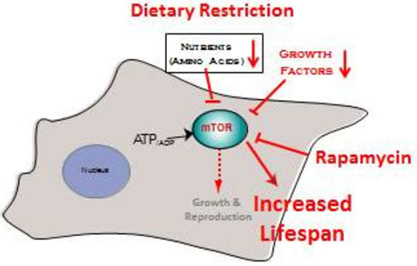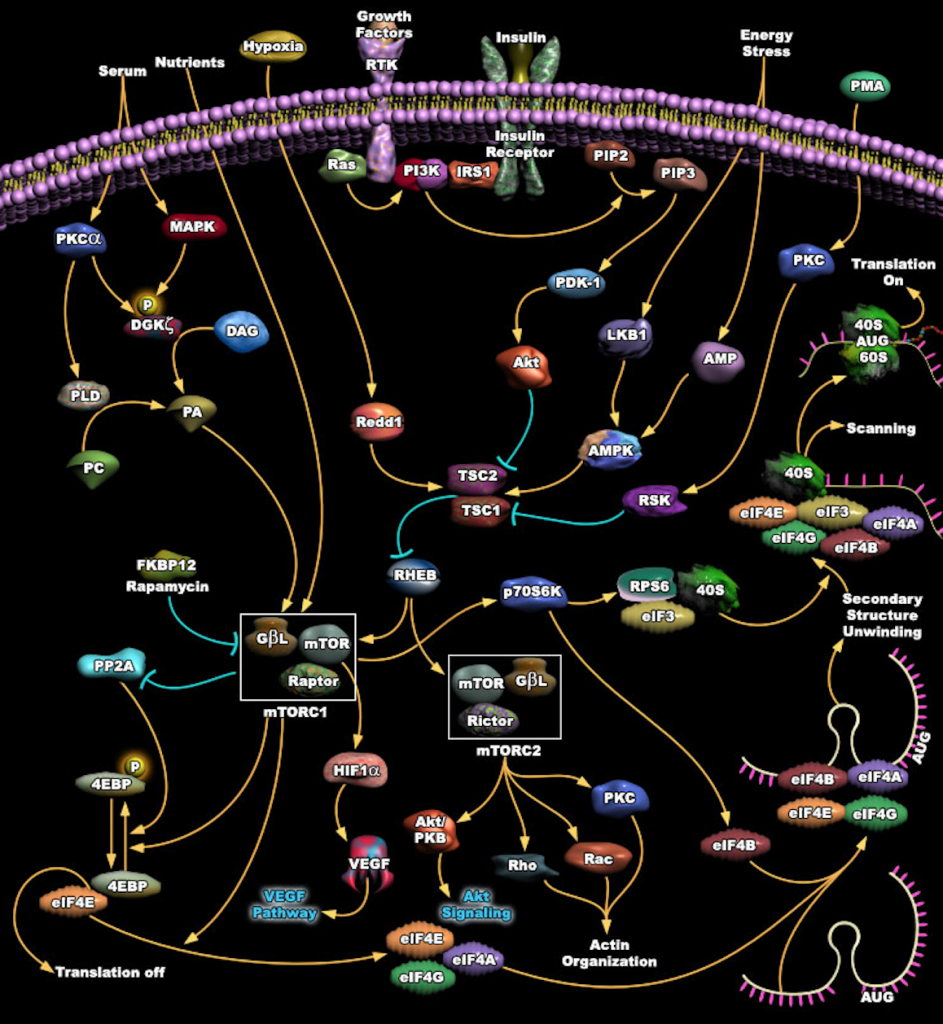The human body has a special protein called the mammalian target of rapamycin (mTOR for short). When mTOR is activated, it triggers muscle hypertrophy (an increase in muscle size) through an increase in protein synthesis (how your body turns protein into muscle tissue.
Whenever we have lots of nutrition (mainly protein) and calories, we essentially tell the body that plentiful times are here. mTOR is the protein that “senses” this, and signals our cells to increase their working capacity and ATP (energy) production. Cells also divide and reproduce faster, which primes the body for rapid growth and repair.
It’s important to realize that mTOR can increase performance and we shouldn’t view it as either good or bad. It more like depends. mTOR is one of those things that’s good to have cycled. Sometimes we want to increase it to grow muscle and improve certain aspects of cognition, while the rest of the time want to have low levels to increase LONGEVITY decrease cancer risk, and reduce inflammation.
You see, mTOR increases energy production, but also creates more junk products. Autophagy is the process that degrades these junk products. But it is only usually active when mTOR is decreased. In other words, the body doesn’t start cleaning up until the party is over.
Autophagy is equivalent to a ‘detox’ from a scientific perspective. We need a balance between growth/junk products and rest/clean up.
What activates mTOR?
(mTOR) is activated by amino acids, energy status, insulin, growth factors, specific nutrients, or energy deficiency. Including anabolic steroids, β-hydroxy-β-methyl butyrate (HMB), and phosphatidic acid (PA) . Exercise has been shown to increase intracellular levels of the phospholipid PA, and PA activates mTOR signaling

HMB is a supplement used in bodybuilding. HMB, is a metabolite of the essential amino acids Leucine. HMB is thought to play a role in the regulation of protein breakdown in the body
PA is a lipid messenger that has been shown to increase muscle protein synthesis via signaling stimulation of the mammalian target of rapamycin (mTOR).
mTOR aging & negatives effects
Many studies have shown that too much mTOR activity can accelerate aging. Lowering mTOR has been shown to increase the lifespan in several different species, including mice, yeast, worms, and flies.
Conserved hallmarks of aging have recently been proposed and include telomere attrition, epigenetic alterations, genomic instability, loss of proteostasis, deregulated nutrient sensing, mitochondrial dysfunction, cellular senescence, stem cell exhaustion, and altered intercellular communication. Too much mTOR activation is associated with a large number of human diseases, including cancer, obesity, acne, type 2 diabetes, depression, and neurodegeneration. mTor is associated with cancer and an increase in angiogenesis a process through which new blood vessels form from pre-existing vessels, helping tumors grow. And possibly leading to increased intestinal inflammation.

Diseases Associated With mTOR Activation
The following conditions are commonly associated with mTOR overactivation. It’s important to note that this doesn’t necessarily mean that everyone with overactive mTOR will actually develop them! Many different genetic and environmental factors can influence the risk.
Aging
Cancer
Autoimmune disease
Depression
Diabetes
Obesity
Alzheimer
Kidney disease
Epilepsy
Autism
Chronic pain
SLE
How to inhibit mTOR naturally?
Fasting and severe calorie restriction.
Epigallocatechin gallate (EGCG)
Caffeine
Curcumin
Resveratrol
Protein restriction
Keto Diet
Exercise
NAC
Omega 3
Olive oil
R-Lipoic Acid
Fisetin
Quercetin
Apigenin
DIM
Alcohol
Milk Thistle
Oleanolic Acid
Grape Seed Extract
Astragalus
Carnosine
Which drugs inhibit mTOR?
Rapamycin: is the main mTOR inhibitor
Metformin: inhibit mTOR through upstream pathway / lowers your blood sugar levels
Tacrolimus: prevents organ rejection after transplant in its oral form (immune suppressant)
Rapamycin: Its the main mTOR inhibitor prevents the body from rejecting a transplanted kidney (immune suppressant)
Temsirolimus: Its a targeted cancer drug treatment called an mTOR inhibitor
Everolimus: Its is a targeted cancer drug that blocks cancer growth / mTOR inhibitor
Activators of mTOR
The main activators of mTOR are a variety of amino acids and the hormone insulin. Testosterone is also capable of activating mTOR.
Protein-rich in leucine
Excess Calories
Excess Carbs
Exercise / in the brain, muscles, and heart, but blocks it in the liver and fat cells
IGF-1
Insulin
Testosterone
Ghrelin/signals hunger to the hypothalamus
Leptin/signals regulating food intake
Thyroid hormone
Oxygen
SUMMERY
For health and longevity, we want systemic mTOR levels to be low most of the time, with occasional periods of activation. And have mTOR active in your brain and muscle rather than in your cells and live which we achieve through exercise.


